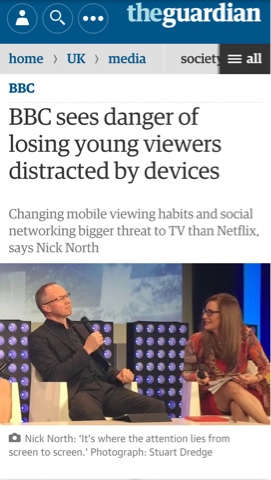"Galtung and Ruge (1981) defined a set of news values to explain how journalists and editors decided that certain stories and photographs were accepted as newsworthy, while others were not."
How has new and digital media technology changed Galtung and Ruge’s news values?
- Immediacy: has it happened recently?
New and digital has effected the concept of immediacy within the news through the fact that audiences can constantly able to access different news stories, through mediums such as Twitter or search engines, Google or Yahoo. This news value has thus been positively impacted by the growth of new and digital media as audiences are more prone to accessing the regularly updated news.
- Familiarity: is it culturally close to us in Britain?
The familiarity news value has been effected by the growth of new and digital media in a positive way as audiences are able to consume the new technological developments in multiple places across the UK and find news specific for their region. The new technological developments allow audiences to find out their local weather smart phones, which is more efficient than the traditional means.
- Amplitude: is it a big event or one which involves large numbers of people?
The amplitude news value has been heightened through new and digital media technologies as news can be spread to vast groups on social networking sites, alongside news institution's applications that are provided free of access on smartphones, i.e. BBC news. Specifically, hashtags are used regularly on Twitter, to enhance the severity of news stories among a wide cross section of the public, so this is another prime example of the benefits new technologies have brought to news values.
- Frequency: does the event happen fairly regularly?
In regards to the frequency value, some events may not happen on a regular basis or be too familiar for audiences, thus they may not be interested in consuming them or happen to find out about them. For instance, 'Twitter' and 'Facebook' are such vast social mediums and not all of the tweets and statuses are seen by large groups of people, especially if they are not popular, thereby resulting in a consumption decrease.
- Unambiguity: is it clear and definite?
The unambiguity news value is arguably negatively effected by the growth of new and digital media as there may be an increase in unreliabilty due to the recent ability to film and photograph events (Citizen Journalism). This content may then be skewed and used in 'news stories' in the incorrect context, thus jeopardising the clarity and definite validation of the news stories.
- Predictability: did we expect it to happen?
The predictability news value is accentuated through new and digital media technologies as audiences are presented with a greater amount of news, most which would be unexpected. For example, citizen journalism such as the 'Eric Garner: "I can't breathe.."' case, is prime evidence of news that may have not been reported unless new technologies and citizen journalism were around. Thereby, the overall predictability of news has changed as audiences are constantly exposed with news that wouldn't have been labelled as "news", unless it was captured through citizen journalism or featured on a social networking site such as Twitter or Facebook.
- Surprise: is it a rare or unexpected event?
Linking the surprise news value with the predictability value, they both have proven to be heightened positively through new and digital media technologies as audiences are presented with content that initially would have been restricted from viewing such as, the Virginia TV Shooting, 2015. Through new technologies such as the video application on Twitter, alongside Youtube, the murder and ex-presenter was able to upload live footage of the attack onto the e-media platforms for audiences to see. These technological developments thus illustrate to audiences 'surprising' news that is rare and unexpected - as proven in the extreme incident of the Virginia Shooting.
- Continuity: has this story already been defined as news?
The continuity news value is reiterated upon new technological developments such as 'Twitter' through the ability of hashtagging. This allows audiences to remain familiarised with important news stories, alongside enhancing the continuity of the news stories as researchers and journalists can constantly add to existing articles while maintaining their target audiences.
- Elite nations and people: which country has the event happened in? Does the story concern well-known people?
New and technological developments have impacted the elite nations and people values positively as social networking sites in particular, craze upon news associated with the "rich, famous and elite". Specifically, news applications found on smart phones such as the 'Daily Mail', focus solely on informing audiences of celebrity gossip and news articles. This is a perfect example of news values successfully utilising new and digital media developments.
- Negativity: is it bad news?
The negativity news values has arguably turned towards positive news through new and digital media feeding audiences with an increasing amount of advertisements that tap into their interests, when they are consuming news. For instance, the 'click-bait' found upon most websites in association a consumers history, is then advertised when they browse on different news websites. This possibly then desensitizes the graphic content that audiences may be exposed to, as they are also shown advertisements that tap into their pleasures and interests.
- Balance: the story may be selected to balance other news, such as a human survival story to balance a number of stories concerning death.
The balance news value has been impacted effectively on new and digital technologies as audiences are proposed with a greater variety of news stories, some that compliment each other and others which juxtapose greatly. For instance, 'The Guardian' highlights a dense amount of stories in relation to different sub genres, and within that genre there tends to be a lot of juxtaposing articles to prevent a sense of bias associated with the overall category, i.e. drug related issues with black youth vs. white drug smugglers.











